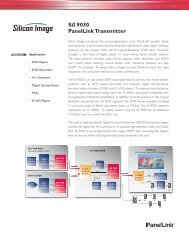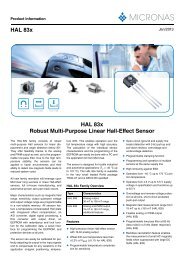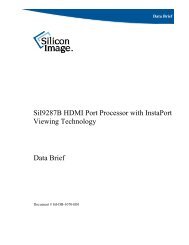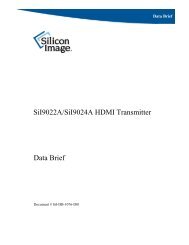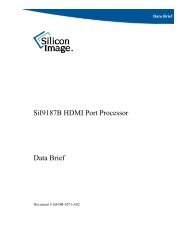nRF24Z1 S-PDIF connections - SemiconductorStore.com
nRF24Z1 S-PDIF connections - SemiconductorStore.com
nRF24Z1 S-PDIF connections - SemiconductorStore.com
You also want an ePaper? Increase the reach of your titles
YUMPU automatically turns print PDFs into web optimized ePapers that Google loves.
WHITE PAPER<br />
<strong>nRF24Z1</strong> S/<strong>PDIF</strong> <strong>connections</strong><br />
1. Introduction<br />
Much existing digital audio equipment features digital interfaces. The <strong>nRF24Z1</strong><br />
AudioStreamer features a digital audio link. There should be no need to do AD and DA<br />
conversions where digital signals exist. This document addresses different cases where the<br />
SPDIO pin of the <strong>nRF24Z1</strong> is connected to existing digital equipment. The <strong>nRF24Z1</strong> can also<br />
connect via an I2S interface. This interface is not considered in this document. Please beware<br />
that the <strong>nRF24Z1</strong> has to be configured by an external microcontroller or EEPROM to use the<br />
S/<strong>PDIF</strong> interface.<br />
The <strong>nRF24Z1</strong> uses the same physical pin for S/<strong>PDIF</strong> output and input. When the <strong>nRF24Z1</strong> is<br />
used as a wireless audio transmitter (ATX) it is near an audio source, and its S/<strong>PDIF</strong> pin is an<br />
input. When it is used as a wireless audio receiver (ARX) it is near an audio destination, and<br />
its S/<strong>PDIF</strong> pin is an output.<br />
2. Definition<br />
S/<strong>PDIF</strong> stands for Sony Philips Digital Interface. It is a <strong>com</strong>monly used way to connect digital<br />
audio equipment. It is defined in a standard named “iec958”.<br />
S/<strong>PDIF</strong> merges the digital data and a clock reference on the same signal. Rise and fall times in<br />
the cable and the transmitting and receiving electronics determine how well the initial clock<br />
signal can be regenerated at the receiving end. Bad rise and fall times may cause signal<br />
dependant jitter on the receiver. Because of this, keep your S/<strong>PDIF</strong> circuitry as simple as<br />
possible.<br />
3. Typical use<br />
There are a few places where you typically encounter S/<strong>PDIF</strong> signals.<br />
1) Digital audio output from CD and DVD players (coax)<br />
2) Digital audio input to HiFi amplifier (coax)<br />
3) Digital audio output from PC (coax)<br />
4) Digital audio output from CD and DVD players (optical)<br />
5) Digital audio input to HiFi amplifier (optical)<br />
6) Digital audio output from portable CD player (optical)<br />
7) Internal connection to AC3 / DTS decoder chip<br />
These different use cases will be explained below. Their effect on the <strong>nRF24Z1</strong> will be<br />
emphasized.<br />
Nordic Semiconductor ASA - Vestre Rosten 81, N-7075 Tiller, Norway - Phone +4772898900 - Fax +4772898989<br />
Page 1 of 6 May 2005
WHITE PAPER<br />
<strong>nRF24Z1</strong> S/<strong>PDIF</strong> <strong>connections</strong><br />
3.1. Cases 1, 2, and 3<br />
This is the most <strong>com</strong>mon way to connect S/<strong>PDIF</strong> devices. Many end customers have seen the<br />
yellow coax plugs (RCA or “phono” plug) at the back of their DVD players and amplifiers.<br />
The signal on this plug must not be confused with audio (red and white phono plugs) or<br />
<strong>com</strong>posite video (yellow phono plug). On these, the signal is referred to ground inside the<br />
player or amplifier. The big difference between these signals and S/<strong>PDIF</strong> is that coax S/<strong>PDIF</strong><br />
is isolated from the internal ground by means of a transformer. Also, the voltage level on coax<br />
S/<strong>PDIF</strong> is 0.5Vpp differential.<br />
The cable itself has a characteristic impedance of 75Ω. Because the merged data and clock<br />
signal carried by the S/<strong>PDIF</strong> cable contains high frequencies and sharp edges, proper<br />
termination is required.<br />
A floating, differential, 75Ω cable at 0.5Vpp doesn’t easily connect to a modern CMOS chip.<br />
Therefore, a network consisting of termination, transformer, booster (usually a 7404 or<br />
<strong>com</strong>parator) and resistors is needed to convert the signal. The network for receiving S/<strong>PDIF</strong><br />
from a coax cable is similar but not equal to the network needed for transmitting S/<strong>PDIF</strong> on a<br />
coax cable.<br />
The <strong>nRF24Z1</strong> demo kit uses a conversion network that can be adapted to both reception and<br />
transmission of S/<strong>PDIF</strong>. Please consult the demo kit documentation for schematic and bill of<br />
materials.<br />
Beware that the conversion network is only needed when you have to connect to a standard<br />
S/<strong>PDIF</strong> cable. If you plan to connect to the S/<strong>PDIF</strong> output from a PC or CD/DVD player, use<br />
a conversion network at the <strong>nRF24Z1</strong> ATX (audio transmitter). If you plan to connect to the<br />
S/<strong>PDIF</strong> input of an audio amplifier, use a conversion network on the <strong>nRF24Z1</strong> ARX (audio<br />
receiver).<br />
3.2. Cases 4, 5, and 6<br />
Some digital audio sources use an optical output. The name of this signal is Toslink, where<br />
“Tos” stands for Toshiba. The main difference between Toslink and coax S/<strong>PDIF</strong> is that<br />
Toslink uses fiber optics and optical transfer of signals. That means there is a light transmitter<br />
in the Toslink connector in the CD/DVD player and a light sensitive receiver in the Toslink<br />
connector of the audio receiver.<br />
If your product is going to interface to the optical digital output of a CD/DVD player, it will<br />
need a Toslink receiver connector at the <strong>nRF24Z1</strong> ATX. If it connects to the optical digital<br />
input of an audio receiver, it will need a Toslink transmitter connector at the <strong>nRF24Z1</strong> ARX.<br />
The Toslink connectors must be chosen so that they are electrically and logically <strong>com</strong>patible<br />
with the S/<strong>PDIF</strong> input and output voltages of the <strong>nRF24Z1</strong>.<br />
Nordic Semiconductor ASA - Vestre Rosten 81, N-7075 Tiller, Norway - Phone +4772898900 - Fax +4772898989<br />
Page 2 of 6 May 2005
WHITE PAPER<br />
<strong>nRF24Z1</strong> S/<strong>PDIF</strong> <strong>connections</strong><br />
3.3. Case 7<br />
The final case is when you want to use the <strong>nRF24Z1</strong> to transmit <strong>com</strong>pressed digital audio like<br />
AC3 or DTS.<br />
This is typically done where multi channel decoding is performed after the signal has been<br />
transmitted wirelessly. The S/<strong>PDIF</strong> output pin from the <strong>nRF24Z1</strong> is a CMOS signal. The<br />
S/<strong>PDIF</strong> input pin on the surround decoder may also be CMOS <strong>com</strong>patible. Then there is no<br />
need for transformers or optical devices in the signal path. The designer only has to take care<br />
that the <strong>nRF24Z1</strong> output voltage is <strong>com</strong>patible to the decoder input voltage. A small series<br />
resistor should also be added close to the <strong>nRF24Z1</strong> in the signal path to reduce the effects of<br />
stray capacitance and inductance.<br />
So far, only the ARX side of a multi channel decoding product has been addressed. The ATX<br />
side (at the audio source) can be configured independently of the ARX. If the source is<br />
S/<strong>PDIF</strong>, care must be taken to design the correct interface.<br />
The <strong>nRF24Z1</strong> supports several formats on the S/<strong>PDIF</strong> interface. (The quoted IEC numbers are<br />
part of the S/<strong>PDIF</strong> definition which is <strong>com</strong>mercially available from IEC.)<br />
• Consumer Linear PCM Audio described in IEC 60958-3.<br />
• Non-Linear PCM Audio described in IEC 61937-1 (General) and IEC 61937-2 (Burstinfo)<br />
When it <strong>com</strong>es to Non-Linear PCM audio, the <strong>nRF24Z1</strong> is transparent to the specific audio<br />
<strong>com</strong>pression algorithms used, so it should cover all the described formats in IEC 61937-3 to<br />
61937-7 namely: AC-3, MPEG-1,-2 Audio, DTS, MPEG2-AAC, ATRAC and ATRAC2/3.<br />
<strong>nRF24Z1</strong> just transfers what <strong>com</strong>es in on the input side covered by IEC 61937-2 (Burst-info)<br />
to the receiver side.<br />
Nordic Semiconductor ASA - Vestre Rosten 81, N-7075 Tiller, Norway - Phone +4772898900 - Fax +4772898989<br />
Page 3 of 6 May 2005
WHITE PAPER<br />
<strong>nRF24Z1</strong> S/<strong>PDIF</strong> <strong>connections</strong><br />
LIABILITY DISCLAIMER<br />
Nordic Semiconductor ASA reserves the right to make changes without further notice to the<br />
product to improve reliability, function or design. Nordic Semiconductor does not assume any<br />
liability arising out of the application or use of any product or circuits described herein.<br />
LIFE SUPPORT APPLICATIONS<br />
These products are not designed for use in life support appliances, devices, or systems where<br />
malfunction of these products can reasonably be expected to result in personal injury. Nordic<br />
Semiconductor ASA customers using or selling these products for use in such applications do<br />
so at their own risk and agree to fully indemnify Nordic Semiconductor ASA for any damages<br />
resulting from such improper use or sale.<br />
White paper. Revision Date: 2005-05-04<br />
All rights reserved ®. Reproduction in whole or in part is prohibited without the prior written<br />
permission of the copyright holder.<br />
Nordic Semiconductor ASA - Vestre Rosten 81, N-7075 Tiller, Norway - Phone +4772898900 - Fax +4772898989<br />
Page 4 of 6 May 2005
WHITE PAPER<br />
<strong>nRF24Z1</strong> S/<strong>PDIF</strong> <strong>connections</strong><br />
YOUR NOTES<br />
Nordic Semiconductor ASA - Vestre Rosten 81, N-7075 Tiller, Norway - Phone +4772898900 - Fax +4772898989<br />
Page 5 of 6 May 2005
WHITE PAPER<br />
<strong>nRF24Z1</strong> S/<strong>PDIF</strong> <strong>connections</strong><br />
Nordic Semiconductor - World Wide Distributor<br />
For Your nearest dealer, please see http://www.nordicsemi.no<br />
Main Office:<br />
Vestre Rosten 81, N-7075 Tiller, Norway<br />
Phone: +47 72 89 89 00, Fax: +47 72 89 89 89<br />
Visit the Nordic Semiconductor ASA website at http://www.nordicsemi.no<br />
Nordic Semiconductor ASA - Vestre Rosten 81, N-7075 Tiller, Norway - Phone +4772898900 - Fax +4772898989<br />
Page 6 of 6 May 2005


